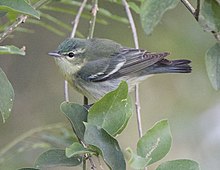| Cerulean warbler | |
|---|---|

| |
| Adult male cerulean warbler | |

| |
| Adult female cerulean warbler | |
| Scientific classification | |
| Domain: | Eukaryota |
| Kingdom: | Animalia |
| Phylum: | Chordata |
| Class: | Aves |
| Order: | Passeriformes |
| Family: | Parulidae |
| Genus: | Setophaga |
| Species: | S. cerulea
|
| Binomial name | |
| Setophaga cerulea (Wilson, 1810)
| |

| |
Breeding range
Migration range
Wintering range
| |
| Synonyms | |
|
Sylvia cerulea Wilson, 1810[2] | |
The cerulean warbler (Setophaga cerulea) is a small songbird in the family Parulidae. It is a long-distance migrant, breeding in eastern North American hardwood forests. In the non-breeding season, it winters on the eastern slope of the Andes in South America, preferring subtropical forests.
It displays strong sexual dichromatism: Adult males have cerulean blue and white upperparts, with a black necklace across the breast and black streaks on the back and flanks. Females and immature birds have bluish-green upperparts, a pale stripe over the eye, no streaking, and are yellow below. All have two white wing bars and a thin, pointed bill.
The cerulean warbler is insectivorous and predominantly feeds on insect larvae, though it also takes winged insects. It forages for prey and nests high in forest canopies. Individuals are strongly territorial; males will defend areas of forests. Males arrive on breeding grounds about one to two weeks earlier than females. Breeding and incubation take place from late May to early June.
The species is rated as near threatened on the International Union for Conservation of Nature (IUCN)'s Red List of endangered species, indicating it is under risk of becoming vulnerable in the near future. The population of the cerulean warbler has been under rapid decline, though in recent years this decline has slowed. Deforestation in its non-breeding range continues to reduce its available habitat.
- ^ BirdLife International (2019). "Setophaga cerulea". IUCN Red List of Threatened Species. 2019: e.T22721740A153691320. doi:10.2305/IUCN.UK.2019-3.RLTS.T22721740A153691320.en. Retrieved 13 November 2021.
- ^ Wilson, Alexander; Ord, George; Lawson, Alexander; Warnicke, John G.; Murray, George; Tanner, Benjamin (1808). American ornithology, or, The natural history of the birds of the United States : illustrated with plates engraved and colored from original drawings taken from nature. Vol. 2. Philadelphia: Published by Bradford and Inskeep, Printed by Robert Carr. pp. 141–142.
- ^ Wilson, Alexander; Ord, George; Lawson, Alexander; Warnicke, John G.; Murray, George; Tanner, Benjamin (1808). American ornithology, or, The natural history of the birds of the United States : illustrated with plates engraved and colored from original drawings taken from nature. Vol. 1. Philadelphia: Published by Bradford and Inskeep, Printed by Robert Carr. p. 119.
- ^ Wilson, Alexander; Lawson, Alexander; Ord, George (1829). American ornithology; or, The natural history of the birds of the United States... By ALexander Wilson. With a sketch of the author's life, by George Ord, F. L. S. & c. Vol. 3. New York: Harrison Hall.
